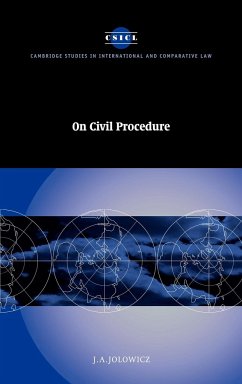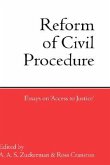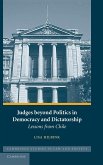- Gebundenes Buch
- Merkliste
- Auf die Merkliste
- Bewerten Bewerten
- Teilen
- Produkt teilen
- Produkterinnerung
- Produkterinnerung
Jolowicz's comparative study examines fundamental conceptions of the law and its societal purposes.
Andere Kunden interessierten sich auch für
![Judging Civil Justice Judging Civil Justice]() Hazel G. GennJudging Civil Justice78,99 €
Hazel G. GennJudging Civil Justice78,99 €![Reform of Civil Procedure Reform of Civil Procedure]() A. A. S. Zuckerman / Ross Cranston (eds.)Reform of Civil Procedure280,99 €
A. A. S. Zuckerman / Ross Cranston (eds.)Reform of Civil Procedure280,99 €![Judging Russia Judging Russia]() Alexei TrochevJudging Russia114,99 €
Alexei TrochevJudging Russia114,99 €![Evaluating Scientific Evidence Evaluating Scientific Evidence]() Erica Beecher-MonasEvaluating Scientific Evidence74,99 €
Erica Beecher-MonasEvaluating Scientific Evidence74,99 €![Judges beyond Politics in Democracy and Dictatorship Judges beyond Politics in Democracy and Dictatorship]() Lisa HilbinkJudges beyond Politics in Democracy and Dictatorship109,99 €
Lisa HilbinkJudges beyond Politics in Democracy and Dictatorship109,99 €![How Solidarity Works for Welfare How Solidarity Works for Welfare]() Prerna SinghHow Solidarity Works for Welfare97,99 €
Prerna SinghHow Solidarity Works for Welfare97,99 €![Procedure On Elegit And Equitable Execution Procedure On Elegit And Equitable Execution]() Frederick StoneProcedure On Elegit And Equitable Execution26,99 €
Frederick StoneProcedure On Elegit And Equitable Execution26,99 €-
-
-
Jolowicz's comparative study examines fundamental conceptions of the law and its societal purposes.
Produktdetails
- Produktdetails
- Verlag: Cambridge University Press
- Seitenzahl: 444
- Erscheinungstermin: 25. März 2008
- Englisch
- Abmessung: 235mm x 157mm x 31mm
- Gewicht: 867g
- ISBN-13: 9780521584197
- ISBN-10: 0521584191
- Artikelnr.: 21609988
- Herstellerkennzeichnung
- Libri GmbH
- Europaallee 1
- 36244 Bad Hersfeld
- gpsr@libri.de
- Verlag: Cambridge University Press
- Seitenzahl: 444
- Erscheinungstermin: 25. März 2008
- Englisch
- Abmessung: 235mm x 157mm x 31mm
- Gewicht: 867g
- ISBN-13: 9780521584197
- ISBN-10: 0521584191
- Artikelnr.: 21609988
- Herstellerkennzeichnung
- Libri GmbH
- Europaallee 1
- 36244 Bad Hersfeld
- gpsr@libri.de
Part I. The Litigation Process: 1. Civil litigation
2. Some twentieth-century developments in Anglo-American civil procedure
3. On the nature and purposes of civil procedural law
4. The dilemmas of civil litigation
Part II. Protection of Diffuse, Fragmented and Collective Interests: 5. Introduction
6. Aspects of US and French law
7. English law
Part III. Procedural Modes: 8. Civil and administrative procedure
9. Adversarial and inquisitorial approaches to civil litigation
Part IV. The Parties and the Judge: 10. Da mihi factum dabo tibi jus: a problem of demarcation in English and French law
11. Fact-finding
12. The expert, the witness and the judge in civil litigation: French and English law
13. The use by the judge of his own knowledge (of fact or law or both) in the formation of his decision
Part V. Recourse against Judgements: 14. Civil appeals in England and Wales
15. Appeal, cassation, amparo and all that: what and why?
16. Managing overload in appellate courts: 'Western' countries
Part VI. Procedural Reform: 17. 'General ideas' and the reform of civil procedure
18. Reform of English civil procedure: a derogation from the adversary system?
19. The Woolf reforms.
2. Some twentieth-century developments in Anglo-American civil procedure
3. On the nature and purposes of civil procedural law
4. The dilemmas of civil litigation
Part II. Protection of Diffuse, Fragmented and Collective Interests: 5. Introduction
6. Aspects of US and French law
7. English law
Part III. Procedural Modes: 8. Civil and administrative procedure
9. Adversarial and inquisitorial approaches to civil litigation
Part IV. The Parties and the Judge: 10. Da mihi factum dabo tibi jus: a problem of demarcation in English and French law
11. Fact-finding
12. The expert, the witness and the judge in civil litigation: French and English law
13. The use by the judge of his own knowledge (of fact or law or both) in the formation of his decision
Part V. Recourse against Judgements: 14. Civil appeals in England and Wales
15. Appeal, cassation, amparo and all that: what and why?
16. Managing overload in appellate courts: 'Western' countries
Part VI. Procedural Reform: 17. 'General ideas' and the reform of civil procedure
18. Reform of English civil procedure: a derogation from the adversary system?
19. The Woolf reforms.
Part I. The Litigation Process: 1. Civil litigation
2. Some twentieth-century developments in Anglo-American civil procedure
3. On the nature and purposes of civil procedural law
4. The dilemmas of civil litigation
Part II. Protection of Diffuse, Fragmented and Collective Interests: 5. Introduction
6. Aspects of US and French law
7. English law
Part III. Procedural Modes: 8. Civil and administrative procedure
9. Adversarial and inquisitorial approaches to civil litigation
Part IV. The Parties and the Judge: 10. Da mihi factum dabo tibi jus: a problem of demarcation in English and French law
11. Fact-finding
12. The expert, the witness and the judge in civil litigation: French and English law
13. The use by the judge of his own knowledge (of fact or law or both) in the formation of his decision
Part V. Recourse against Judgements: 14. Civil appeals in England and Wales
15. Appeal, cassation, amparo and all that: what and why?
16. Managing overload in appellate courts: 'Western' countries
Part VI. Procedural Reform: 17. 'General ideas' and the reform of civil procedure
18. Reform of English civil procedure: a derogation from the adversary system?
19. The Woolf reforms.
2. Some twentieth-century developments in Anglo-American civil procedure
3. On the nature and purposes of civil procedural law
4. The dilemmas of civil litigation
Part II. Protection of Diffuse, Fragmented and Collective Interests: 5. Introduction
6. Aspects of US and French law
7. English law
Part III. Procedural Modes: 8. Civil and administrative procedure
9. Adversarial and inquisitorial approaches to civil litigation
Part IV. The Parties and the Judge: 10. Da mihi factum dabo tibi jus: a problem of demarcation in English and French law
11. Fact-finding
12. The expert, the witness and the judge in civil litigation: French and English law
13. The use by the judge of his own knowledge (of fact or law or both) in the formation of his decision
Part V. Recourse against Judgements: 14. Civil appeals in England and Wales
15. Appeal, cassation, amparo and all that: what and why?
16. Managing overload in appellate courts: 'Western' countries
Part VI. Procedural Reform: 17. 'General ideas' and the reform of civil procedure
18. Reform of English civil procedure: a derogation from the adversary system?
19. The Woolf reforms.









